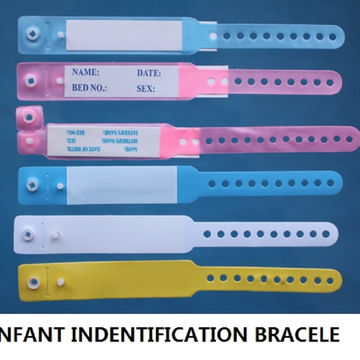The Relevance of Using a Patient Identification Band for each Patient
The Relevance of Using a Patient Identification Band for each Patient
Blog Article
Why Patient Identification Bands Are Important for every single Healthcare Center
In the complicated landscape of medical care, client identification bands function as a fundamental element in guarding person safety and security and reducing clinical mistakes. These bands offer critical details that not only helps with precise identification but additionally enhances communication among healthcare providers. As organizations make every effort to fulfill regulative conformity and enhance general workflow efficiency, the role of recognition bands becomes significantly substantial. Nevertheless, the ramifications of their use prolong beyond plain conformity-- what are the potential repercussions of disregarding this vital practice? Exploring this concern reveals a much deeper understanding of individual safety and quality treatment.
Preventing Medical Errors
In the realm of healthcare, preventing medical mistakes is paramount to ensuring client safety and high quality of care. Among the most important elements in reducing such mistakes is the exact recognition of patients. Misidentification can cause unsuitable treatments, drug errors, and also medical errors, all of which can have terrible effects for people and healthcare suppliers alike.
Individual recognition bands act as an essential device in this preventive method. These bands usually consist of crucial information, such as the client's name, date of birth, and one-of-a-kind identification number, permitting health care experts to confirm the individual's identity quickly and properly before carrying out any treatment. Guaranteeing that these bands are correctly used and regularly utilized throughout all health care settings is essential.
In addition, the execution of digital wellness documents (EHR) can improve the effectiveness of patient identification bands by integrating them with electronic systems that flag possible disparities. Regular training and adherence to protocols regarding making use of person identification bands can dramatically minimize the probability of errors. In summary, durable patient identification practices are necessary for safeguarding and lessening medical mistakes individual welfare within health care atmospheres.
Enhancing Individual Safety And Security
Client safety and security is a multifaceted principle that incorporates various techniques and practices made to shield individuals from injury throughout their medical care experience. One essential component in improving patient security is the implementation of client identification bands. These bands work as an important device for making certain that doctor can accurately recognize individuals, thus lessening the risk of misidentification.
The presence of person identification bands substantially minimizes the possibilities of providing inaccurate medications, carrying out unexpected treatments, or failing to identify allergic reactions. By affixing a distinct identifier to each individual, medical care centers create a trustworthy system that cultivates accountability and watchfulness amongst medical personnel. This proactive technique not only improves the safety of clients yet additionally infuses a sense of count on in the healthcare system.
Moreover, person identification bands contribute to a standard method that can be easily incorporated right into digital health records. Patient Identification Band. This assimilation guarantees that essential individual information is easily easily accessible, more strengthening safety and security actions. Inevitably, the reliable use of recognition bands is a necessary practice that underpins a society of safety and security, aiming to protect clients and improve total health care results
Improving Communication
Effective communication is crucial in the healthcare setting, as it directly affects client safety and security and care top quality. Patient recognition bands serve as an important device for enhancing interaction amongst medical care companies. By plainly presenting vital client information such as name, day of birth, and clinical record number, these bands help with exact recognition, minimizing the risk of mistakes in treatment and medicine administration.
Moreover, client recognition bands cultivate a society of responsibility and verification within health click this site care teams. When all employee are outfitted with immediate accessibility to dependable patient recognition, the probability of miscommunication decreases significantly. Throughout handoffs in between shifts or interdisciplinary examinations, the existence of recognition bands makes certain that every person involved is on the same page pertaining to client identification and medical background, thus minimizing misconceptions.
Furthermore, these bands can integrate with electronic health records (EHR), permitting seamless communication of patient details throughout various platforms. This connection not only enhances the efficiency of information sharing however additionally supports a much more coordinated technique to patient treatment. Ultimately, the adoption of patient identification bands is important for improving interaction, hence adding to far better wellness outcomes and making sure that clients get the highest possible requirement of treatment.

Streamlining Operations
The application of person recognition bands substantially adds to enhancing process within health care settings. By giving clear and immediate identification of clients, these bands decrease the moment medical care experts invest confirming client details. This efficiency decreases the potential for mistakes, permitting team to focus on straight individual treatment as opposed to management tasks.
With standard identification processes, health care teams can quickly access important individual data, including case history, allergies, and therapy plans. This fast access enhances decision-making and enables timely treatments, eventually enhancing individual results. In addition, using recognition bands helps with better control amongst multidisciplinary teams, ensuring that all members have the correct info at their fingertips.

In enhancement, client identification bands can be integrated with digital health record (EHR) systems, even more optimizing operations. By scanning a band, healthcare service providers can rapidly update and share information, thus lowering redundancy and simplifying documents efforts. This combination helps keep a constant flow of details, which is vital in vibrant healthcare setups.
Ensuring Regulatory Compliance
In today's health care landscape, making sure governing compliance is critical for preserving patient security and organizational honesty. Person identification bands play an essential function in meeting numerous governing criteria, such as those stated by the Joint Payment and the Centers for Medicare & Medicaid Provider (CMS) These companies highlight the need of precise individual identification to reduce clinical errors and boost the top quality of care.

Executing standard person identification bands aids health care centers follow regulations that need accurate person recognition at every stage of care. This includes medication management, surgeries, and blood transfusions. Non-compliance can bring about significant consequences, including fines, loss of accreditation, and, most notably, jeopardizing client safety.
Additionally, using innovation, such as barcoding and RFID systems integrated with client identification bands, can even more boost compliance efforts by guaranteeing that the best individual obtains the ideal therapy at the right time. By focusing on the application of durable individual recognition systems, health care facilities not just stick to governing standards yet also cultivate a culture of security and accountability, eventually boosting patient end results and count see on the health care system.

Conclusion
In verdict, person recognition bands act as a fundamental part in health care centers, significantly adding to the prevention of clinical errors and the improvement of patient safety. By improving communication amongst clinical staff and improving workflows, these bands facilitate much more reliable healthcare distribution. Additionally, their role in making certain compliance with regulatory requirements can not be overemphasized. Ultimately, the application of patient recognition bands is crucial for promoting a more secure healthcare environment and improving general individual end results.
In the facility landscape of health care, individual identification bands offer as a fundamental aspect in protecting patient security and minimizing clinical mistakes. These bands usually this consist of essential details, such as the client's name, date of birth, and one-of-a-kind identification number, allowing medical care specialists to confirm the client's identification quickly and accurately prior to providing any type of treatment.Implementing standard patient identification bands aids healthcare facilities abide with guidelines that require exact person recognition at every phase of care.In conclusion, client recognition bands serve as an essential component in healthcare centers, significantly contributing to the prevention of medical mistakes and the enhancement of individual security - Patient Identification Band. Eventually, the application of person recognition bands is essential for promoting a more secure medical care atmosphere and boosting total patient outcomes
Report this page